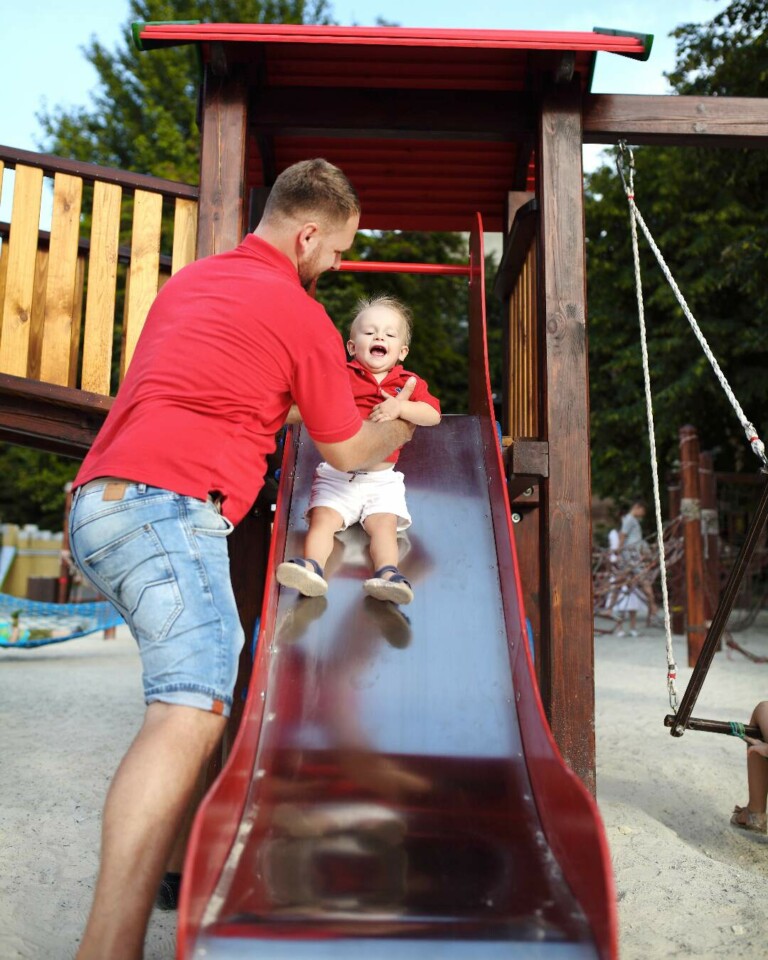As the prevalence of childhood obesity continues to be a concern in the U.S., it is crucial for parents to prioritize including movement and physical activities in their kids’ lives. The first step? Be a positive role model! When parents are active themselves, they have a high chance of instilling a love for movement in their children.
Get moving!
Active parents lead by example.
When kids see their mom and dad living an active life – engaging in activities such as biking, hiking, gardening or yoga and participating in recreation such as tennis, swimming, golf or paddling – they tend to believe staying active is simply an integral part of life.
Furthermore, when parents include their kids in their movement activities, spending time with them outdoors playing and exploring, those kids quickly learn how to appreciate and enjoy the world around them. Without even thinking about it, they’re growing up prioritizing movement, which will benefit their lifelong health and wellness.

Active kids become healthy adults.
According to the Centers for Disease Control and Prevention (CDC), between 2017 and 2020, obesity affected nearly 15 million children and adolescents. That means that 1 in 5 kids is at risk for developing serious health problems – both physically and mentally/emotionally – associated with being overweight.
Obesity and inactivity in childhood are associated with an increased risk of a number of serious health conditions later in life – heart disease, osteoporosis, diabetes, high blood pressure, and even cancer.
Strong evidence also exists that ties sedentary days with decreased academic and social achievement in children. Conversely, regular physical activity can ward off anxiety and depression at a young age while significantly reducing the risk of developing life-threatening diseases as an adult.
The Physical Activity Guidelines for Americans recommends that children aged 3 through 5 years should be physically active throughout the day and children aged 6 – 17 years need at least 60 minutes of moderate to vigorous physical activity every day. Unfortunately, research shows that less than 20 percent of kids meet these recommendations. Additionally, the CDC reports that children age 8 to 10 spend an average of six hours per day in front of a screen, kids age 11 to 14 spend an average of nine hours per day in front of a screen, and youth who are 15 to 18 years old spend an average of seven-and-a-half hours per day in front of a screen.
So, while it may sound like a lot to incorporate an hour of moderate to vigorous activity into busy days full of school, sports, homework, clubs and other commitments, simply trading some of the screen time at home for play and exercise is really not a big ask.
3 tips for encouraging an active lifestyle.
Play with your kids:
Be a leader when it comes to activities with your kids. First and foremost, make it fun! When your kids are little take them outdoors for a game of tag, to build a fort, play catch, or create an obstacle course. Head to the local playground where they can climb and swing and run! As they get older try backyard sports like soccer, whiffle ball or badminton. Bad weather? Crank up the tunes and have a dance party in the living room. Keep in mind that if you have fun being active, your kids will no doubt imitate the positive vibes.

Go on adventures:
Simple walks and bike rides are fun but turning them into adventures can give the activities some staying (and returning) power. Turn your walk into a scavenger hunt or play follow the leader and make it interesting by looping around trees and scrambling over boulders. Older kids love geocaching instead of just hiking – do a little research for options in your area. Go somewhere new on your next bike ride, such as a single track that will push their skills to the next level all while having a blast! A trip to the lake or river can include rock skipping competitions! Mix it up and you’ll see how quickly they say yes the next time you ask if they’re up for an outing!
Provide options & choice:

From toys and games to different parks, facilities and even clubs/leagues, when you give children variety, they’ll be more eager to actively participate in their activities of choice. So, instead of telling them which park you’re going to, ask which one they want to play at! Don’t tell them you’re going skating, ask if they’d rather hit the local rink or the local skate park. Hot outside? Have them choose a water adventure – maybe kayaking or stand-up paddling or maybe creek forging and waterfall chasing. The options are plentiful, and you will be amazed how much more invested kids are when they get to choose.
Having Mom and/or Dad on the journey can go far in motivating a kid to stick with and enjoy new activities. Parents play a crucial role in shaping their kids’ attitudes about physical activity. Being active role models and … practicing what we preach … will foster our kids’ love of movement all while promoting healthy lifestyles that will last them a lifetime. After all, active kids grow into healthy adults.
If you need help getting started, our physical therapists can be a great resource. From injury screenings to designing customized exercise programs to combat the fallout from past lifestyle choices, we look forward to being a part of your family’s healthcare team!
Dedicated to your family's health and wellness.
Our experts are committed to providing effective, efficient, and compassionate care to help people of all ages and abilities live a pain-free, active life doing all the things they love. Your passion is our priority.



